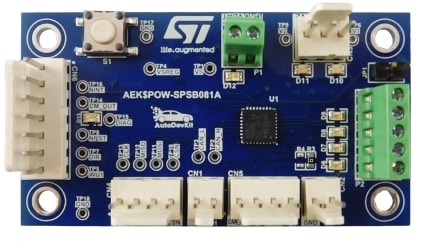Product overview
Description
The AEK-POW-SPSB081 is a power management IC evaluation board with enhanced power management functionalities, such as various standby modes to minimize power consumption with programmable local and remote wake-up capability.
The board is based on the SPSB081 power management system IC, which embeds one low-drop voltage regulator (V1) to supply the system microcontroller and another voltage regulator (V2) to be used as a voltage tracker of V1 or to supply external peripheral loads such as sensors.
V1 has a fixed rail of 5 V and features an overvoltage detection and protection solution, while V2 can work in two different ways: as a voltage tracker of V1, or as an independent voltage regulator programmable via SPI with 5 or 3.3 V.
Four high-side drivers allow supplying and driving LEDs and sensors. These high-side drivers are driven via SPI and can be configured in four different modes: OFF, ON, TIMED (with programmable time), and PWM (configurable via device registers).
Moreover, you can set the high-side driver output to be driven by the DIR pin. This functionality allows the user to generate custom PWM signals for the high-side outputs.
All outputs are short-circuit protected and detect open-load.
The communication protocol used to configure SPSB0815 registers is the SPI, implemented with four wires (MISO, MOSI, CSN, and CLK).
The AEK-POW-SPSB081 also exploits the LIN and CAN transceivers embedded in the IC, allowing the use of the board as a bridge between the microcontroller and the CAN or LIN communication lines.
An external microcontroller (for example, when using an AEK-MCU-C1MLIT1) has to refresh periodically a watchdog TRIG bit in the SPSB081 register via SPI, to maintain the device in active mode.
In case of watchdog failure, the device enters the V1_standby (for energy saving). To wake it up, send a pulse to the WU1_IN pin or just press the S1 button.
By placing a jumper on JP1, the device enters the debug mode where the watchdog is inactive.
Three demos are available in the AutoDevKit ecosystem, each of them based on a different SPC58 microcontroller evaluation board plus an AEK-POW-SPSB081.
The demos show how to use the outputs, configuring them in four different modes: OUT 1 for ON, OUT 2 for TIMED, OUT 3 for PWM and OUT 4 for DIR.
V2 is configured as a linear regulator and changes settings alternatively every 2.5 seconds between 3.3 and 5 V.
CAN connector and CAN_rx/CAN_tx pins are then connected to the microcontroller board.
The CAN test signals transmitted from the microcontroller every five seconds can be effectively decoded through CAN_H/CAN_L pins.
-
All features
- SPSB0815 power management IC is AEC-Q100 qualified
- One 5 V low drop voltage regulator (V1) for the microcontroller and peripheral supply, with a current regulation of 250 mA maximum
- One configurable via SPI low drop voltage regulator (V2) for 5 or 3.3 V, also used as tracker for V1, and with off-board protection, with a current limitation of 100 mA maximum
- Configurable window watchdog from microcontroller
- Debug mode available with watchdog disablement
- ISO 17987-4/2016 compliant LIN transceiver
- ISO 11898-2/2016 and SAE J2284 compliant CAN-FD transceiver with local failure and bus failure diagnosis
- 4 high-side drivers (0.14 A, RON = 7 Ω) configurable in four different modes (OFF, ON, TIMED, and PWM) suitable to drive external LED modules or supply external contacts
- WU1 wake-up pin with programmable cyclic sense functionality
- DIR pin to drive HS outputs (OUT 1 to OUT 4) manually
- Programmable periodic system wake-up feature
- DIAGN output pin to notify system error conditions
- Current monitoring for all internal high-side drivers
- Open-load diagnosis for all outputs
- V1 overvoltage detection and protection
- Device temperature warning and protection



